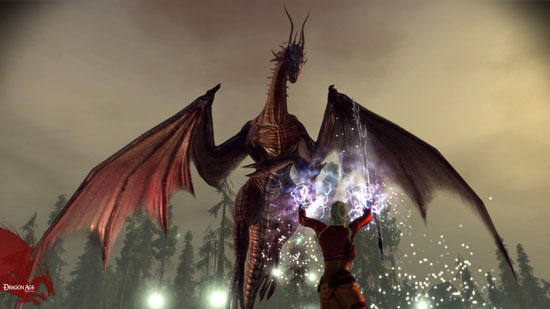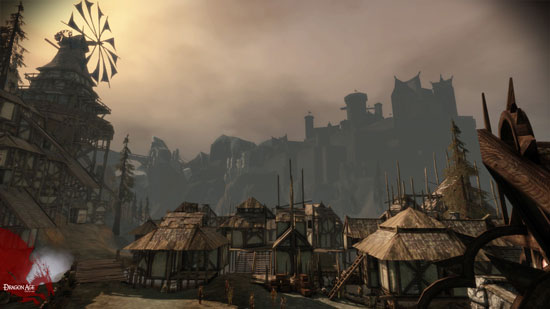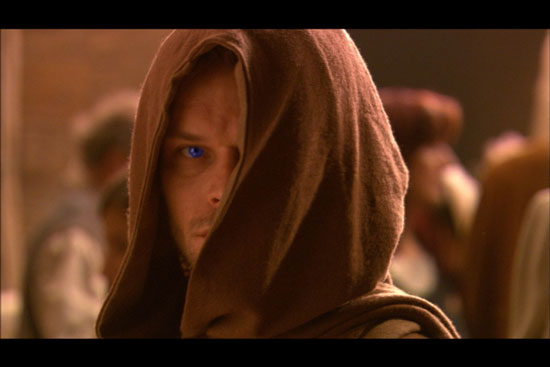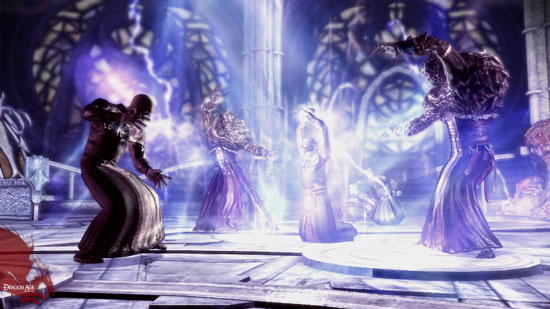 game design,
game design,  gaming,
gaming,  rpgs
rpgs  Wednesday, November 18, 2009 at 5:49PM
Wednesday, November 18, 2009 at 5:49PM  Guess that’s why they call it “Dragon” Age.
Guess that’s why they call it “Dragon” Age.
There’s a lot to admire in BioWare’s latest RPG. The world is vast (at 27 hours of playtime, I’ve progressed through a mere 18% of the game), what parts of the story I’ve explored so far have been enjoyable, and the overall opportunities to actually “role play” feel much richer than in similar entries within the genre. Indeed, getting into the mindspace of an RPG character has always been easier for me at the table with dice, rather than in front of a screen with a controller.
In many ways, the setting of Dragon Age: Origins (which doubles as pencil & paper RPG setting to be released soon, in a smart move by the powers-that-be) has much to recommend it as well. The tension between the Templars and the Circle of Mages is excellent, without establishing either side as the good guys. Sure, the Templars often act like jerks to mages — and everyone else, really — but at the same time, what’s said in the game about careless or weak magicians becoming unwilling vessels for bloodthirsty demons is, you know, true. See, a mage shines like a beacon to the denizens of the Fade, an immaterial realm of dreams, spirits and demons. And like moths to a flame, they hone in on practitioners of the arcane arts to wreak havoc in flesh.
I also love part of the backstory for the creation of the Darkspawn, the primary evil that players battle against in Dragon Age. Way back when, a group of powerful magicians ran out of terrestrial power to covet and acquire. What to do, what to do? they asked themselves. I know! Let’s go to heaven and conquer the vacant city of god! And so they did.
Two words: Bad. Ass.
Now obviously this doesn’t turn out well, since it results in the creation of the Darkspawn. Judging by the name alone, you can probably figure they’re not nice dudes. But at any rate, these are just a couple examples of the parts of Dragon Age that establish an engaging and unique world. It’s a shame, though, that not everything about the game’s world was created with such loving care and an eye to individuality.
 Pictured: New Fantasyton. Motto: “No hobbits here, no sir.”
Pictured: New Fantasyton. Motto: “No hobbits here, no sir.”
The assemblage of races and nations in Dragon Age is your typical Tolkien Standard Array (not a real term, but should be) meets medieval Europe: Welcome to 90% of fantasy settings, fellas. Now, to BioWare’s credit, they subvert a few tropes in their world-building. Elves, for example, are a subjugated race of second-class citizens, having only recently won freedom from their former human masters. Many elves still do serve those same human masters, so recent is the change.
Though dwarves are, sigh, toiling away under mountains crafting the finest weapons & armor in the land, their once mighty empire is now is near-total collapse. And not because they dug too greedily, or too deep! Those Darkspawn mentioned before first bubbled up from the deep parts of the world, and dwarves were the first stop on the path to the apocalypse. But the dwarves can dodge all the blame for that, too — a lifetime living and working with the physical stuff of magic, “lyrium”, has rendered every last dwarf a magical non-starter. Sure enough, it were those dastardly human mages what done the deed. Nice move, guys.
More annoying still are the lazy Euro-centric ethnic stereotypes renamed and redecorated to fit into the fantasy schema. The world might be called “Thedas”, but it still feels a lot like home. The game’s main nation of Ferelden? UK accents and cultural flourishes abound. Nearby Orlais? Home to wine-, fashion-, and bard-loving francophones (so it’s pronounced or-LAY, of course). Somewhat more-removed Antiva? Spanish-accented rogues and schemers. And on and on like that. Obviously, the developers require voice actors from our real world to populate their game, and they will have accents, but there are more interesting ways of addressing this issue, and turning it into an advantage.
Digression time!
 Put in whatever contacts you want, man; I don’t think you’re getting on the cover of National Geographic.I’m a big fan of the two Dune miniseries that were produced by the Sci-Fi Channel. For various reasons, (financial, logistic, etc.) shooting was largely done in studios in Prague, with Czech cast members fleshing out many of the side roles. Notably, nearly all Fremen were played by Eastern European actors, many of them with very distinct Eastern European accents. Now, the Fremen of Dune are already a culture assembled in many respects from historical pastiche: author Frank Herbert borrowed greatly from the Arab and Islamic societies of the Middle East in creating Fremen society.
Put in whatever contacts you want, man; I don’t think you’re getting on the cover of National Geographic.I’m a big fan of the two Dune miniseries that were produced by the Sci-Fi Channel. For various reasons, (financial, logistic, etc.) shooting was largely done in studios in Prague, with Czech cast members fleshing out many of the side roles. Notably, nearly all Fremen were played by Eastern European actors, many of them with very distinct Eastern European accents. Now, the Fremen of Dune are already a culture assembled in many respects from historical pastiche: author Frank Herbert borrowed greatly from the Arab and Islamic societies of the Middle East in creating Fremen society.
It could have been awkward, but when you put swarthy-looking Czechs in stillsuits and have them start treading the sands, suddenly disparate elements are working in your favor. The Fremen are a race of humans on a desert planet in the far future, where Earth is but a memory. Having our expectations subverted (seeing a white guy in Bedouin kit speaking oddly-accented English) gives our imagination some more room to suspend disbelief. In a game, where all the visuals can be created from whole cloth, there’s no reason a similar technique couldn’t work. (Complain all you want, but you can’t say appropriating the English patois of the Caribbean region didn’t help create a… unique culture for Star Wars’ Gungans.)
None of these elements seems obvious in the first hours of play. But as your progress toward acquiring the Urn of Sacred Ashes becomes more and more almost-comically identical to the quest of Arthur’s knights for the Holy Grail, it’s hard not to feel like someone just pulled a quick “search-and-replace” on the Wikipedia pages for history and folklore of the Dark Ages, then slapped it all on a new map.
There are some rough spots in the plot as well, which are perhaps more jarring for for the story’s overall quality. But I haven’t seen it through to the end yet, and I’ve detected a few whiffs that plot machinations that seem rote or obvious at first blush might have a little more complexity to them, as the player and their heroic surrogate both learn more.
 Don’t mind us, just doin’ a little light demon summoning before supper.
Don’t mind us, just doin’ a little light demon summoning before supper.
Truly, though, Dragon Age has captured my attention in admirable fashion, regardless of any flaws it has. The decision to include six different starting zones based on character creation choices, with six separate introductory stories, is an excellent move — all the more so since those choices have real effect on the game world. Play as an elf, for example, and expect to be on the receiving end of human prejudice fairly often, and have the opportunity to confront the same head on, both in social and combat encounters.
Welcome, too, is the lack of any kind of “morality continuum” for the playable characters, mechanics-wise. Instead, your options change only your standing in the eyes of your adventuring party as permanent effects go, with possible ramifications for the greater narrative, depending on what’s at stake. So rather than worrying about earning immersion-breaking “dark side points”, you can concentrate on maintaining the trust and esteem of your friends and allies as you make your mark on the world. Much more realistic, and much more amenable to complex decision-making. So, too, is it easier for a player to have their character make interesting choices (and ones more in keeping with a unique outlook) without being penalized by the game.
I think more than anything, it’s those two game design choices that draw me in, by letting me imagine my character as a realistic person and having the game reflect and give opportunities to realize that image. The flashes of originality that can be found in its world of Thedas are a factor as well. I just hope that I won’t continue discovering more seams and frayed edges in the world as I explore it.
 game design,
game design,  gaming,
gaming,  rpgs
rpgs  Saturday, August 22, 2009 at 1:21AM
Saturday, August 22, 2009 at 1:21AM Blizzard Entertainment recently made the speculation of many a fan site a reality with the announcement of World of WarCraft: Cataclysm. The third expansion for WoW looks like it’s going to change the game in a fundamentally different way than The Burning Crusade and Wrath of the Lich King, the two expansions that precede Cataclysm.
The key difference is that TBC and WotLK, as expansions, primarily filled in blank spaces on the map of Azeroth. A few changes were made in old zones to facilitate the new content — the shifting of NPCs to Outland, or the construction of new travel hubs to reach Northrend — but for the most part, the areas from classic, or “vanilla”, WoW remained unchanged.
Cataclysm will break widely from this pattern. While content patches have had their effect on the existing areas of the game world (opening the gates of Ahn-Qiraj; the construction of the Argent Coliseum), and the “phasing” techniques introduced for WotLK were put to good use reshaping zones to reflect player actions, this new expansion will be dramatically altering old world content forever, and for everyone.
In brief, disastrous events are radically changing places players have grown familiar with. Some locations are flooded, others are overrun with lava, still others have sprung into new lushness and vitality. All this is being worked into the storyline of the Cataclysm expansion, with the added benefit of allowing the WoW developers to put everything they’ve learned designing new content to work in older, lower-level areas.
Indeed, for all the beauty of Northrend and strange majesty of Outland, many players experienced only a taste of Blizzard’s labor. The classic problem with the MMO system is that new content is produced to be tacked on after existing content — to appease those who have reached the end and wish there to be farther to go.
New races, as those in Burning Crusade, and now in Cataclysm, are one way to inject new material for everyone to enjoy. All players are able to create new characters in these new starting areas without needing to progress through existing content to see the new parts. Cataclysm is also allowing new race and class combinations, creating more opportunities for low-level newness.
Interestingly, Blizzard is also restructuring some old, lower-level content to be challenging to the current top end; in a short while the old Onyxia raid instance will be re-release with a version tuned for level 80 players. A similar retuning was announced for the instances of Dead Mines and Shadowfang Keep for Cataclysm.
The usefulness of this strategy is less immediately obvious than making new content that is available at low levels — why bother taking old content and shifting upward for the top-tier to enjoy? But the satisfaction of gamer nostalgia, not to mention the very real opportunity to make something new while avoiding creating it from scratch, make it a sound choice (even if the storyline explanations may end up a little contrived).
Revamping old content in this way is a likely crowd-pleaser, for veterans and newcomers (who may have missed such content the first time around) alike. How well the choice to drastically chance old zones completely will go over, however, is far from clear. Certainly some will be distressed to see favorite old content gone, or cry foul over lore developments for beloved zones and characters.
Cataclysm may be more of a gamble than WoW’s past expansions. Granted, the size of Blizzard’s playerbase means any expansion is almost bound for success, but I’m glad to see that the biggest player in the MMO arena isn’t resting on their laurels or sticking to business as usual. Count me as a fan — though if Garrosh Hellscream is indeed becoming the new Warchief of the Horde, I may have some difficult choices to make in the months ahead.
 Sunday, August 16, 2009 at 2:24AM
Sunday, August 16, 2009 at 2:24AM In my circle of friends, tabletop RPGs are a fairly regular portion of our weekly social activities — falling as often as twice a week, and sometimes more during the summer. Most of those who play are content to be players, are frequently busy with other concerns, or new to the hobby in general; such that of the eight or so of us known to roll the d20, only two of us run games for the most part.
As a dungeon master, or DM, perhaps the chief task is simply getting the right bodies at the table — once that goal is achieved, the rest often falls into place. Much as many DMs (myself included) enjoy preparing a suite of challenges for players to face, often the most predictive factor for fun in a night’s session is the percentage of players in attendance.
What to do then in summer, when the selection of players likely undergoes a semi-permanent change? At this stage in my life, and that of a large swath of RPG players, school of some sort is often still a part of the equation. In summer, some players are bound to have returned from abroad for a few months, or be returning to a hometown elsewhere until the fall semester. They might taking on accelerated summer courses that demand more full-time attention, or just working more hours at their job to prepare for the next round of tuition.
The games I run tend to be longer campaigns; one-shots just aren’t in my blood. A rotating player base, however, can throw a wrench into this process. So this summer, to accommodate this change (and the three-month stay of a former mainstay of our D&D group), I devised a game meant to specifically operate in the summer months only, then go on hiatus for the other eight or nine months of the year.
Making it happen was surprisingly easy, though the skeleton of the campaign was built to accommodate just this schedule in particular (the aforementioned player is attending an out-of-state grad school, and will be returning for the next two summers as well). In brief, the players were recruits for a covert military arm of the government, tasked with the retrieval of a specific individual.
I made that goal the only concrete part of my planned narrative; depending on the actions of players, that goal might be reached within a handful of play sessions, or only at the very end. With that goal achieved, the organization that recruited them might have further need of them, but only in situations that required “special attention.” Essentially, a hiatus was built into framework of the game’s story — call it “the sequel structure.”
To prepare for next summer’s edition of the same campaign, I planted a few plot seeds throughout this year’s sessions — elements that were tangential to the main plot, yet designed to pique the players’ curiosity. In addition, much of the last session of the summer before the player dissolved was given over to more story- and player-focused interludes. The next time we play, several years will have passed for the player characters, each of which will have been pursuing their own individual goals up until that time; addressing this specifically in the last session helps provide a launching point for the characters’ off-screen adventures.
Plotting a game this way is not unlike writing a screenplay that anticipates its own sequel several years down the line. Rather than pick up precisely where the last story left off, in the gap between films the characters of some series age and change, in minor if not major ways. And inevitably, events conspire to reunite and push them once more into the realm of action.
As examples, consider the sequels to Ocean’s Eleven, The Mummy, or the host of Star Trek films: All share a mostly-static array of characters and themes, yet aren’t devoted to the telling of a single tale. A campaign that uses the sequel structure should work similarly. Doing so will also lend itself to the real-life considerations of a summer RPG campaign — some players will be apart from others for months, and almost a year will pass between the end of one batch of sessions and the next. What might otherwise be a logistical problem is instead actively used to enhance the verisimilitude of the game being played.
Using the sequel structure is also a prime opportunity for a DM to make significant changes within the game world, without the pace of events seeing unrealistic. Players can design their characters with more complete social spheres, even families of their own. Their characters are only “on-duty” for a few weeks or months every couple of years in game-time, letting them break free of the usual adventuring life in the meantime. It’s almost as if the characters are in the RPG equivalent of the National Guard!
As gamers age, being able to meet around a table ready to play increasingly takes a backseat to other life concerns. But in thinking ahead, a clever DM can anticipate for these interruptions and plan for them, or as in cases like this, even harness and build on them. Part of the draw of RPGs is their endless flexibility, and rarely to DMs design a session that feels like duplicate of the one before it. Just as the story of a game adapts in response to the actions a player’s character takes, the style and format of a campaign is free to adapt in response to the changes in players’ real lives.
This obviously works both ways — one day, the game that was sequel-structured could become a more regular affair. Let it be as major a change in the lives of your characters as it is in the lives of your players!
 Nathan | |
Nathan | |  Post a Comment
Post a Comment  Friday, August 14, 2009 at 4:05AM
Friday, August 14, 2009 at 4:05AM Perhaps this time, yes? Forget those other times: They do not matter, do not count. Do not even exist, in fact; leastwise, not from all the way over here.
This post is a Beginning. Ideally, the End will be far off. A vast gulf of time and space ought to fall ‘twixt those two polar opposites — anything less, shameful and failure-ridden.
 Nathan | |
Nathan | |  Post a Comment
Post a Comment  Thursday, July 17, 2008 at 1:37PM
Thursday, July 17, 2008 at 1:37PM Welcome to your new Squarespace site! Below is a video that shows you how to get started using our system.
The three most important things to keep in mind:
Want to remove this entry? Enter content mode by pressing the 'A' on the upper right, then press 'remove' next to the title of this entry.
 Nathan | |
Nathan | |  Post a Comment
Post a Comment